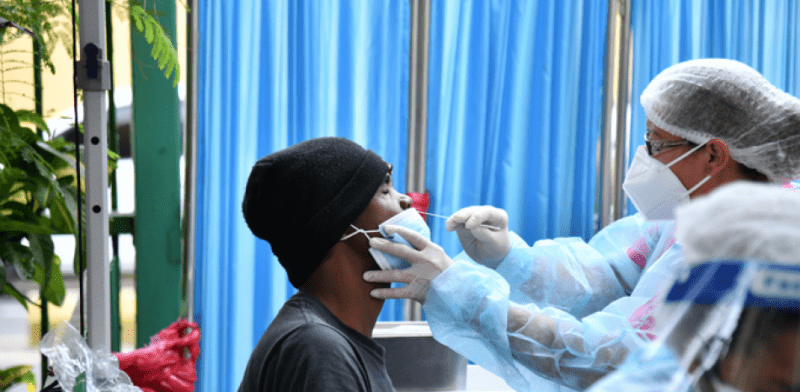Santo Domingo – The Dominican Republic is witnessing a steady increase in COVID-19 cases, alongside a broader spike in respiratory illnesses, according to the Ministry of Public Health’s latest epidemiological bulletin.
In the past three weeks alone, health authorities confirmed 247 new COVID-19 cases, including 84 between June 8 and 14. This brings the country’s total to 681 confirmed cases for the year. The National District leads with 28 cases, followed by Santiago (19) and Santo Domingo province (8). The provinces with the highest cumulative incidence rates were Duarte (175.97) and the National District (172.07 per 100,000 residents).
The country’s overall positivity rate for COVID-19 laboratory tests currently stands at 10%.
Public Health Response and Recommendations
The Ministry is urging citizens, especially those in high-risk categories, to get vaccinated against both COVID-19 and influenza. Authorities are also recommending indoor mask use, frequent handwashing, and maintaining proper ventilation.
Citizens are advised to seek medical attention if symptoms such as persistent fever or difficulty breathing arise. The Ministry emphasized the importance of relying on official sources for information and avoiding the spread of unverified claims.
Emerging Variant: “Nimbus”
Meanwhile, international health agencies have raised concerns over a newly identified COVID-19 variant, NB.1.8.1, nicknamed “Nimbus.” This subvariant of Omicron is spreading rapidly across parts of Europe, prompting warnings of a potential surge in infections in the coming months.
Though considered highly contagious, Nimbus is reportedly less lethal than earlier strains. Its symptoms include fever, fatigue, muscle aches, nasal congestion, cough, gastrointestinal discomfort, and in some cases, a severe sore throat.
The World Health Organization (WHO) confirmed it is monitoring the new strain but has assessed the overall risk to global public health as low.
Increase in Severe Acute Respiratory Infections
In addition to COVID-19, the Dominican Republic has documented 734 suspected cases of Severe Acute Respiratory Infection (SARI) this year, with 28 related deaths. Forty of those cases were recorded in the past week alone. Last year during the same period, 815 suspected SARI cases were reported along with five deaths.
Experts describe SARI as a sudden-onset respiratory infection accompanied by high fever, coughing, and difficulty breathing, often requiring hospitalization and mechanical ventilation.
Other Respiratory Viruses in Circulation
Laboratory testing from June 8–14 revealed continued circulation of various respiratory viruses. Influenza was the most dominant, with a 12.9% positivity rate, followed by COVID-19 (2.9%) and other viruses such as Parainfluenza (4.3%).
Among the specific influenza strains detected were Influenza A (H1N1) pdm09, Influenza A (H3N2), and Influenza B (Victoria lineage). These findings were based on 70 respiratory samples analyzed at the Dr. Defilló National Laboratory.
Malaria and Dengue Updates
Four new cases of malaria were reported in the most recent epidemiological week, with three cases originating from San Juan and Azua—both considered endemic zones. The year’s total malaria cases now stand at 435, with Azua accounting for 50% and San Juan 41% of cases. Notably, 29% of those affected are Haitian nationals, while 71% are Dominican, primarily women aged 20 to 29.
Dengue infections are also being monitored, with 128 confirmed cases reported so far in 2025. This represents a significant 86% decrease compared to the same period in 2024. The provinces with the highest number of cases include Espaillat (10.9%), La Vega (9.4%), and Puerto Plata (7.8%).
Maternal and Infant Mortality
No maternal deaths were reported last week, a development attributed to improved prenatal care in public health centers. As of week 24, the country has recorded 79 maternal deaths, down from 87 during the same period last year.
In terms of infant mortality, 23 deaths were reported in the most recent week, bringing the total to 771 for the year—a reduction of 242 compared to the same period in 2024.
Health officials continue to stress the importance of routine prenatal checkups, balanced nutrition, and lifestyle precautions for pregnant women.
Drug Abuse and Public Health Impact
Coinciding with the International Day Against Drug Abuse and Illicit Trafficking on June 26, the Ministry of Health highlighted ongoing efforts to combat drug-related health and safety issues.
Authorities have expanded educational and prevention campaigns, particularly in schools and communities, and implemented treatment and rehabilitation programs aimed at reintegrating patients into society.
The public health cost of drug abuse is considerable. A 2022 study estimated that the country spends over US$5 million annually on treatment for drug users. The broader impact includes a rise in communicable diseases like HIV and hepatitis, mental health issues, increased violence tied to drug trafficking, and overall higher public health and social service burdens.
Looking Ahead
The Ministry of Public Health continues to closely monitor the evolving epidemiological landscape and urges the public to follow all health guidelines. With respiratory illnesses on the rise and new COVID-19 variants emerging globally, maintaining public health vigilance remains a national priority.

